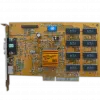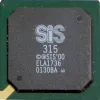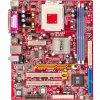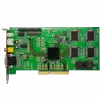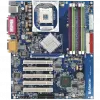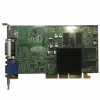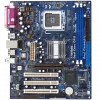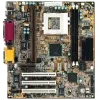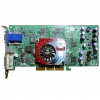The Accelerated Graphics Port (also called Advanced Graphics Port, often shortened to AGP) is a high-speed point-to-point channel for attaching a graphics card to a computer's motherboard, primarily to assist in the acceleration of 3D computer graphics. Between 2004 and 2007, AGP was replaced by PCI Express.
As computers became increasingly graphically oriented, successive generations of graphics adapters began to push the limits of PCI, a bus with shared bandwidth. This led to the development of AGP, a "bus" dedicated to graphics adapters.
For the needs of modern graphics adapters, AGP is superior to PCI because it provides a dedicated pathway between the slot and the processor rather than sharing the PCI bus, allowing for faster communication. AGP also uses sideband addressing, meaning that addressing for packets is carried outside of the packet, so the entire packet does not need to be read to get addressing information. In addition, to load a texture, a PCI graphics card must copy it from the system's RAM into the card's framebuffer, whereas an AGP card is capable of reading textures directly from system RAM using the Graphics Address Remapping Table (GART). GART reapportions main memory as needed for texture storage, allowing the graphics card to access them directly. The maximum amount of system memory available to AGP is defined as the AGP aperture.
The two main reasons graphics cards with the PCI interface are still produced are that, first, they can be used in nearly any PC; because while some motherboards with built-in graphics adapters lack an AGP slot, few, if any, modern desktop PCs lack PCI slots. Secondly, a user with an appropriate operating system can use several PCI graphics cards (or several PCI graphics cards in combination with one AGP card) simultaneously — to give many different video outputs (for the use of many screens). This is almost impossible with AGP 1.0 and AGP 2.0 cards, because they do not support more than one AGP Master (video card) per AGP Target (chipset interface). AGP 3.0 does support more than one AGP Master per AGP Target, but nonetheless few PC motherboards are equipped with more than one AGP slot. Some server-class computers support having multiple AGP slots in a single system: the HP AlphaServer GS1280 has up to 16 AGP slots, the AlphaServer ES80 up to 4 AGP slots, and the AlphaServer ES47 up to 2 AGP slots.
The AGP slot first appeared on x86 compatible system boards based on Socket 7 Pentium and Slot 1 Pentium II processors. Intel introduced AGP support with the i440LX Slot 1 chipset in mid-October 1997 and a flood of products followed from all the major system board vendors.
The first Socket 7 chipsets to support AGP were the VIA Apollo VP3, SiS 5591/5592, and the ALI Aladdin V. Intel never released an AGP-equipped Socket 7 chipset. FIC demonstrated the first Socket 7 AGP system board in November 1997 as the FIC PA-2012 based on the VIA Apollo VP3 chipset, followed very quickly by the EPoX P55-VP3 also based on the VIA VP3 chipset which was first to market.
Early video chipsets featuring AGP support included the Rendition Vérité V2200, 3dfx Voodoo Banshee, NVIDIA RIVA 128, 3Dlabs PERMEDIA 2, Intel i740, ATI Rage series, Matrox Millennium II, and S3 ViRGE GX/2. Some early AGP boards used graphics processors built around PCI and were simply bridged to AGP. This resulted in the cards benefiting little from the new bus, with the only improvement used being the 66 MHz bus clock, with its resulting doubled bandwidth over PCI, and bus exclusivity. Examples of such cards were the Voodoo Banshee, Vérité V2200, Millennium II, and S3 ViRGE GX/2. Intel's i740 was explicitly designed to exploit the new AGP feature set. In fact it was designed to texture only from AGP memory, making PCI versions of the board difficult to implement (local board RAM had to emulate AGP memory.)
Microsoft first introduced AGP support into Windows 95 OEM Service Release 2 (OSR2 version 1111 or 950B) via the USB SUPPLEMENT to OSR2 patch. After applying the patch the Windows 95 system became Windows 95 version 4.00.950 B. The first Windows NT-based operating system to receive AGP support was Windows NT 4.0 with service pack 3, introduced in 1997. Linux support for AGP enhanced fast data transfers was first added in 1999 with the implementation of the AGPgart kernel module.
